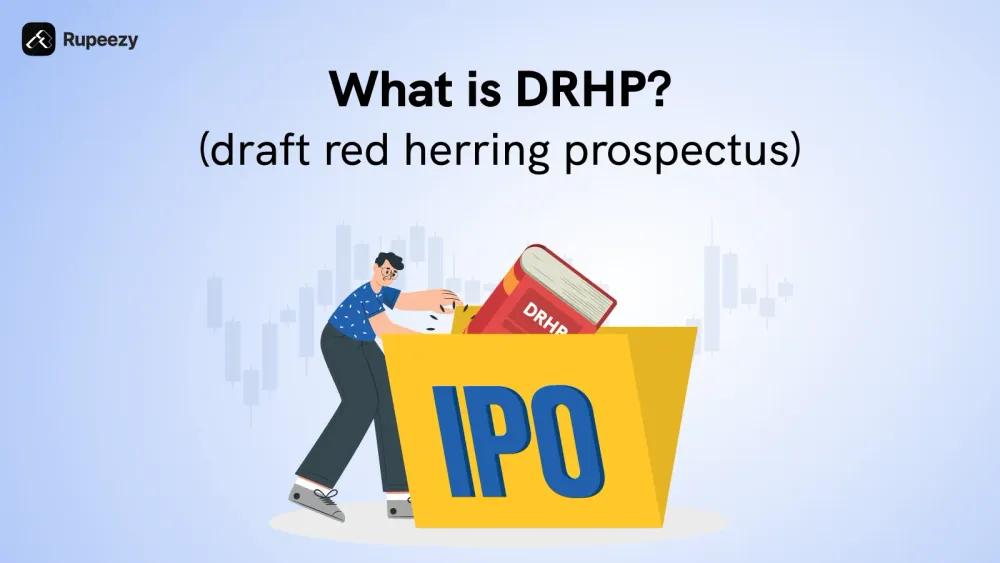What is DRHP (Draft Red Herring Prospectus)


00:00 / 00:00
Are you planning to invest in the IPO? If yes, then you must understand the key terms associated with the investment. For starters, there is a price, issue date, allotments, and so on. But there is one more key term to know, which is DRHP.
But what is DRHP, and why does it matter to investors? The DRHP stands for Draft Red Herring Prospectus. It’s a preliminary document submitted by a company before it launches its IPO. This draft contains all the important details about the business, its financials, risks, and future plans.
In this blog, let us explore the meaning of DRHP and all the key aspects associated with it.
DRHP Meaning
The DRHP is a preliminary document that is filed by a company with the Securities and Exchange Board of India (SEBI). It is done when it intends to raise capital from the public through an Initial Public Offering (IPO).
The DRHP is also referred to as an "offer document." It serves as the first step in the IPO process. The key features of the DRHP are as follows:
Filed before launching an IPO for SEBI review
Contains company details, financials, and risk factors
Does not specify final share price or issue size
Open for public and regulatory feedback
Subject to changes based on SEBI observations
Helps investors assess the company before investing
Purpose of a DRHP
The Draft Red Herring Prospectus (DRHP) is a key document in the IPO process. It outlines important details about the company and serves both regulatory and investor needs. Below are the main purposes of filing a DRHP in an IPO:
1. Ensure Transparency
It provides clear disclosures about the company’s business model, financials, management, and risk factors. This ensures transparency for potential investors and regulators before the IPO launch.
2. Help Investors Evaluate the Company
It gives investors a chance to assess the company’s fundamentals, market potential, and future strategy, helping them make informed investment decisions.
3. Meet SEBI Regulatory Requirements
The DRHP is submitted to SEBI for review. SEBI checks for accuracy and completeness of the information, ensuring the IPO complies with regulations and protects investor interests in the stock market.
4. Invite Public Feedback
Once filed, the DRHP is made public to gather comments from investors, analysts, and stakeholders. This feedback can lead to updates or clarifications before the final prospectus is released.
5. Clarify Use of IPO Funds
The document clearly explains how the raised funds will be used. This shares details of the amount to be used for business expansion, debt repayment, or other objectives. This transparency builds investor confidence and shows alignment with company goals.
The Draft Red Herring Prospectus supports informed decision-making, safeguards investor interests, and ensures a smooth IPO process through full disclosure and regulatory compliance.
Key Sections Inside a DRHP
Here are the key sections in the DRHP (draft red herring prospectus):
1. Prospectus Summary
This section gives a brief overview of the entire DRHP. It includes the company name, offer size, key financials, business summary, and risk highlights. It serves as a quick reference for investors looking to understand the IPO at a glance.
2. Business/Company Overview
Here, the DRHP explains the nature of the company’s business, its core products or services, and geographical presence. It sets the context for investors unfamiliar with the company’s operations.
3. History of the Company
This part traces the company’s origin, milestones, and development timeline. It helps investors understand the company's journey and credibility over the years.
4. Business Model and Operations
The section outlines how the company earns revenue, its operational structure, and cost model. This helps investors assess business sustainability and efficiency.
5. Industry Overview and Market Position
It provides an analysis of the industry the company operates in, key trends, growth potential, and how the company is positioned among competitors in the stock market.
6. Strengths and Strategies
This part highlights the company’s competitive advantages and future strategies. It shows how the company plans to maintain or improve its market position post-IPO.
7. Management and Promoter Details
Investors get details about the leadership team and promoters, their qualifications, experience, and shareholding. This helps build trust and credibility.
8. Corporate Governance
This section outlines the governance policies, board committees, and compliance practices. It assures investors about ethical and regulatory standards.
9. Financial Statements and Key Financial Data
One of the most critical parts of the DRHP in IPO, it includes detailed audited financials, income statements, balance sheets, cash flows, and performance ratios.
10. Summary Financial Information
A snapshot of key financial numbers like revenue, profit, and margins over the past few years—helpful for quick analysis and comparison.
11. Management Discussion and Analysis (MD&A)
This is where the management discusses business operations, risks, industry dynamics, and financial performance. It gives insight into the company’s internal thinking and future outlook.
12. Risk Factors
Lists all possible risks—internal and external—that could affect business operations or investor returns. A must-read section in any DRHP document.
13. Objects of the Issue (Use of Proceeds)
This section clearly explains how the company plans to use the funds raised from the IPO, such as debt repayment, capital expenditure, or business expansion.
14. Offer Details (Structure, Size, Allocation)
Investors find information about the total issue size, pricing, share allocation across retail, QIB, and NII categories, and book-building details.
15. Capital Structure and Shareholding Pattern
Describes the company's share capital before and after the IPO. It includes promoter holding, public shareholding, and changes post-listing.
16. Dividend Policy
States whether the company has a history of paying dividends, and what its dividend distribution plans are after the IPO.
17. Legal and Regulatory Information
Lists the legal framework, licenses, and approvals required to operate. Also covers any compliance issues and statutory obligations.
18. Pending Litigations and Legal Proceedings
This section discloses any lawsuits or disputes involving the company, promoters, or directors that may impact business or reputation.
19. Related Party Transactions
Details transactions the company has with its promoters, group companies, or key management, ensuring transparency in financial dealings.
20. Material Contracts and Documents for Inspection
Lists agreements and contracts investors can inspect, such as underwriting, vendor, or loan agreements, offering more clarity on operations.
21. Other Statutory and General Information
Covers miscellaneous but important items like IPO timelines, registrar details, compliance declarations, and IPO procedure guidelines.
22. Glossary of Terms
Defines key technical, legal, and financial terms used across the Draft Red Herring Prospectus, making it easier for readers to follow.
Why is the DRHP Important for Investors?
For any investor planning to invest in an IPO, understanding the Draft Red Herring Prospectus (DRHP) is crucial. This document acts as the first window into the company’s business, financial health, risks, and future plans. It allows investors to make better decisions based on facts rather than hype. Below are the key reasons why the DRHP is important for investors:
1. Informed Decision-Making
The DRHP provides a full overview of the company’s business model, financial performance, and market standing. This helps investors decide whether the IPO aligns with their goals and if the business has the potential for future growth.
2. Risk Identification
Investors can review detailed disclosures about industry risks, financial threats, operational hurdles, and legal matters. This section of the draft red herring prospectus helps in understanding the possible downside before making a commitment.
3. Financial Clarity
Audited financial reports and key ratios are included in the DRHP, allowing investors to assess revenue trends, profit margins, debt levels, and overall financial health. This supports clear and data-based investment decisions.
4. Management Transparency
The DRHP lists the background of promoters and key executives. This helps investors assess the leadership team’s experience, track record, and governance style, all of which play a key role in long-term company success.
5. Purpose of Fundraising
One of the most important parts of the DRHP in IPO is the explanation of how the raised funds will be used. Whether for expansion, debt repayment, or acquisitions, investors get clarity on how their money will be allocated.
6. Regulatory Assurance
Since the DRHP is reviewed and approved by SEBI before public release, investors can trust that the disclosures meet regulatory standards. This gives added confidence in the accuracy and completeness of the shared information.
Where Can You Find DRHPs?
If you are planning to invest in an IPO, accessing the company’s Draft Red Herring Prospectus (DRHP) is the first step toward informed decision-making. Here are the most reliable places to find a DRHP:
1. SEBI Website
The Securities and Exchange Board of India publishes all DRHPs filed by companies under the “Public Issues” section. You can visit www.sebi.gov.in and check the latest draft filings submitted for regulatory approval.
2. Stock Exchange Website
Both the NSE (National Stock Exchange) and BSE (Bombay Stock Exchange) list DRHPs under their IPO or public issue sections. These platforms offer direct downloads and detailed IPO schedules for investor reference.
3. Company Websites
Most companies upload their DRHP in the investor relations or IPO section of their official websites. This is a quick way to get the original version of the document as submitted to SEBI.
4. Stock Broking Platforms and Financial Portals
Reputed brokerage firms and financial portals like Moneycontrol often host DRHPs for upcoming IPOs. They may also provide easy-to-read summaries for a quicker understanding.
These sources ensure that every investor can access, read, and review the DRHP in IPO filings before applying, helping them make well-informed investment decisions.
DRHP vs RHP - Key Differences
Both DRHP and RHP are key documents in the IPO process. While they serve different purposes and are filed at different stages, both play a role in investor awareness and regulatory compliance.
Below is the difference between DRHP and RHP.
Parameters | DRHP | RHP |
Stage of Filing | Filed at the early stage of the IPO process, before SEBI approval | Filed after SEBI approval, just before the IPO opens for subscription |
Purpose | Provides preliminary disclosure for SEBI review and public feedback | Serves as the final document for investors to make investment decisions |
Content | Includes business details, financials, and risks, but does not mention price band or issue size | Contains everything in the DRHP, plus final issue size, price band, IPO dates, and share allocation |
Approval Status | Not approved by SEBI; open for comments and revisions | Fully approved by SEBI and used for public offering |
Public Availability | Available for public review and analysis | Available for public investment and subscription |
Modifications Allowed | Can be revised based on SEBI suggestions or public input | Only minor changes are allowed after SEBI approval |
Regulatory Requirement | Filing is mandatory before the RHP to start the IPO approval process | Filing is mandatory to launch the IPO and open it to public investment |
How to Analyze a DRHP Like a Financial Analyst
Analyzing a Draft Red Herring Prospectus (DRHP) is essential for understanding whether an IPO is worth your investment. Financial analysts follow a step-by-step approach to study the company’s fundamentals, risk profile, and overall offering. Here is how you can do the same with clarity and confidence.
1. Business Model and Industry Position
Evaluate Scalability: Study the company’s revenue sources, client dependency, and overall scale. Look for diverse income streams and long-term demand potential.
Analyze Industry Context: Check the size of the sector, its expected growth, regulatory environment, and key competitors. A fast-growing industry adds weight to the company’s future plans.
Perform SWOT Analysis: Use the business overview section of the DRHP to identify strengths, weaknesses, opportunities, and threats based on company disclosures.
2. Financial Deep Dive
Measure Profitability: Track EBITDA margins, return on equity, and return on capital employed over the last three to five years. These metrics help judge operational strength.
Assess Liquidity and Leverage: Review current ratio, quick ratio, debt-to-equity ratio, and interest coverage to understand short-term and long-term financial health.
Check Cash Flow Trends: Be alert to warning signs like irregular cash flow, slowing revenue, or narrowing margins. These may indicate operational issues.
Review Audit Notes: Look at the auditor’s report for comments or qualifications. These may reveal hidden financial or legal concerns not evident in the numbers.
3. Management and Governance
Verify Promoter Background: Research promoters for any legal issues, past regulatory violations, or reputational concerns. A clean record reflects responsible leadership.
Study Shareholding Patterns: Check for promoter pledges or sudden changes in institutional holdings. Consistency shows confidence and long-term commitment.
Evaluate Governance Quality: Examine the structure of the board, the presence of independent directors, and disclosures of related-party transactions. Strong governance builds trust.
4. Risk Assessment
Rank Key Risks: Identify major risks from the risk factors section. Classify them based on severity and likelihood of financial impact.
Check Legal Proceedings: Review the legal section for active cases, past fines, or pending litigations. Assess potential liabilities and their financial effect on the business.
5. IPO Specifics
Review Fund Utilization: Confirm how the IPO funds will be used. Spending on debt reduction or expansion is usually more reassuring than vague goals like general working capital.
Compare Valuation Multiples: Study the price-to-earnings and price-to-book ratios. Compare these with listed peers to see if the IPO is priced reasonably.
Understand Lock-In Periods: Check how long promoters and anchor investors are required to hold shares. Longer lock-ins may signal confidence in the company’s future.
6. Technical and Analytical Tools
Extract and Analyze Data: Use tools like Excel or Python to pull financial tables and run trend analysis across years.
Visualize Key Metrics: Create simple line graphs or bar charts to track revenue, expenses, and profit trends. Visual aids make complex data easier to understand.
Analyst’s Quick Reference Table
Section | Key Focus Areas | Tools and Techniques |
Financials | Margin trends, debt sustainability, cash flow patterns | Ratio analysis, growth tracking |
Risk Factors | Risk ranking, mitigation clarity, disclosure quality | Impact-probability matrix |
Management | Experience, governance practices, shareholding changes | Background checks, promoter stake analysis |
IPO Structure | Offer size, use of funds, price justification | Peer comparison, valuation models |
Red Flags to Watch for in a DRHP
When reviewing a Draft Red Herring Prospectus (DRHP), it is important for investors to look beyond the surface. While the document is designed to inform, it may also reveal early signs of trouble. Here are key red flags that may indicate higher risk or a weak investment case:
1. Vague or Limited Disclosures
If the DRHP lacks detail about the company’s business model, revenue sources, financials, or risk factors, it may suggest that the company is withholding important information or facing uncertainties it does not wish to disclose.
2. Weak or Unproven Management
Promoters or executives with limited experience in the industry, a track record of failed ventures, or prior ethical issues should be viewed with caution. Leadership strength plays a big role in long-term performance.
3. Substantial Pending Litigations
A long list of ongoing or unresolved lawsuits involving the company or its promoters can become a major liability. Check the legal proceedings section carefully for financial exposure and reputational risk.
4. Aggressive or Unclear Use of IPO Proceeds
If the DRHP mentions generic uses like “general corporate purposes” or emphasizes debt repayment without a solid expansion plan, it may reflect poor strategic planning or a focus on short-term fixes.
5. High Promoter Stake Dilution
A large drop in promoter shareholding after the IPO could mean promoters are reducing their involvement. This may indicate a lack of confidence in the company’s future performance.
6. Excessive Related Party Transactions
Numerous or unexplained transactions with promoter-owned or affiliated entities may signal conflict of interest, mismanagement, or potential misuse of IPO funds.
7. Inconsistent Financials
Watch out for sudden jumps in revenue, drastic margin swings, or frequent changes in accounting methods. These may be signs of financial manipulation or unstable operations.
8. Downplayed Sector or Market Risks
If the DRHP avoids discussing real industry challenges, regulatory threats, or competitive pressures, it could mean the company is not being transparent about risks that may impact future earnings.
Conclusion
A Draft Red Herring Prospectus (DRHP) is more than just a regulatory document. It is your first real look into a company’s strengths, weaknesses, financial health, and growth plans before it enters the stock market. By learning how to read and analyze a DRHP, you can avoid common IPO pitfalls and invest with clarity.
FAQs
1. How much time does it take for an IPO to launch after the DRHP is filed?
Once a company files its Draft Red Herring Prospectus (DRHP) with SEBI, it typically takes two to three months for the IPO to launch. This time is used for SEBI review, public feedback, and finalizing details before releasing the Red Herring Prospectus (RHP).
2. How do I read a DRHP?
To read a DRHP, start with the business overview, followed by financial statements, risk factors, and the section on the use of IPO proceeds. Focus on profitability metrics, management background, industry outlook, and any red flags. A systematic approach helps you evaluate the company like a financial analyst.
3. Why should I analyze a DRHP before investing in an IPO?
The DRHP in IPO filings contains all important information about the company’s business, financial health, risks, and future plans. Analyzing it allows you to make informed investment decisions instead of relying on market hype or speculation.
4. Can a DRHP change before an IPO is launched?
Yes, a Draft Red Herring Prospectus can be revised after submission. SEBI may suggest changes, and companies can update sections based on investor feedback or market conditions. The final document, called the Red Herring Prospectus (RHP), includes all approved changes.
5. What is DRHP in IPO?
The DRHP, or Draft Red Herring Prospectus, is a preliminary document filed by a company planning to go public. It contains details about the business, financials, risks, and how the raised funds will be used. It is reviewed by SEBI before the IPO opens.
6. What is the difference between DRHP and RHP?
The DRHP is filed at the beginning of the IPO process and does not include final pricing or subscription dates. It is reviewed by SEBI and is open for feedback. The RHP is the final approved document released just before the IPO, with complete offer details for investors.
Check Out These Related Articles |
The content on this blog is for educational purposes only and should not be considered investment advice. While we strive for accuracy, some information may contain errors or delays in updates.
Mentions of stocks or investment products are solely for informational purposes and do not constitute recommendations. Investors should conduct their own research before making any decisions.
Investing in financial markets are subject to market risks, and past performance does not guarantee future results. It is advisable to consult a qualified financial professional, review official documents, and verify information independently before making investment decisions.

All Category







